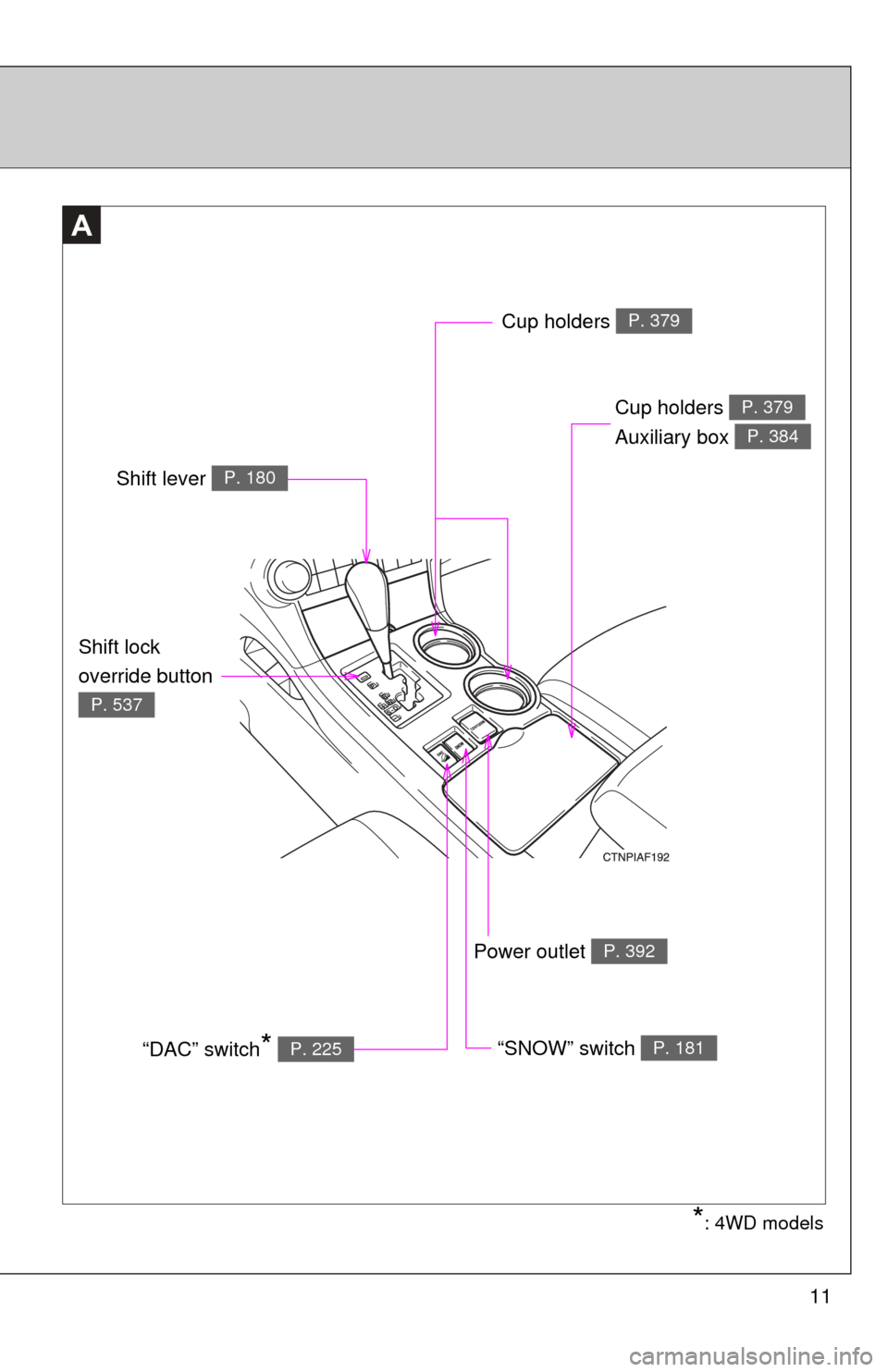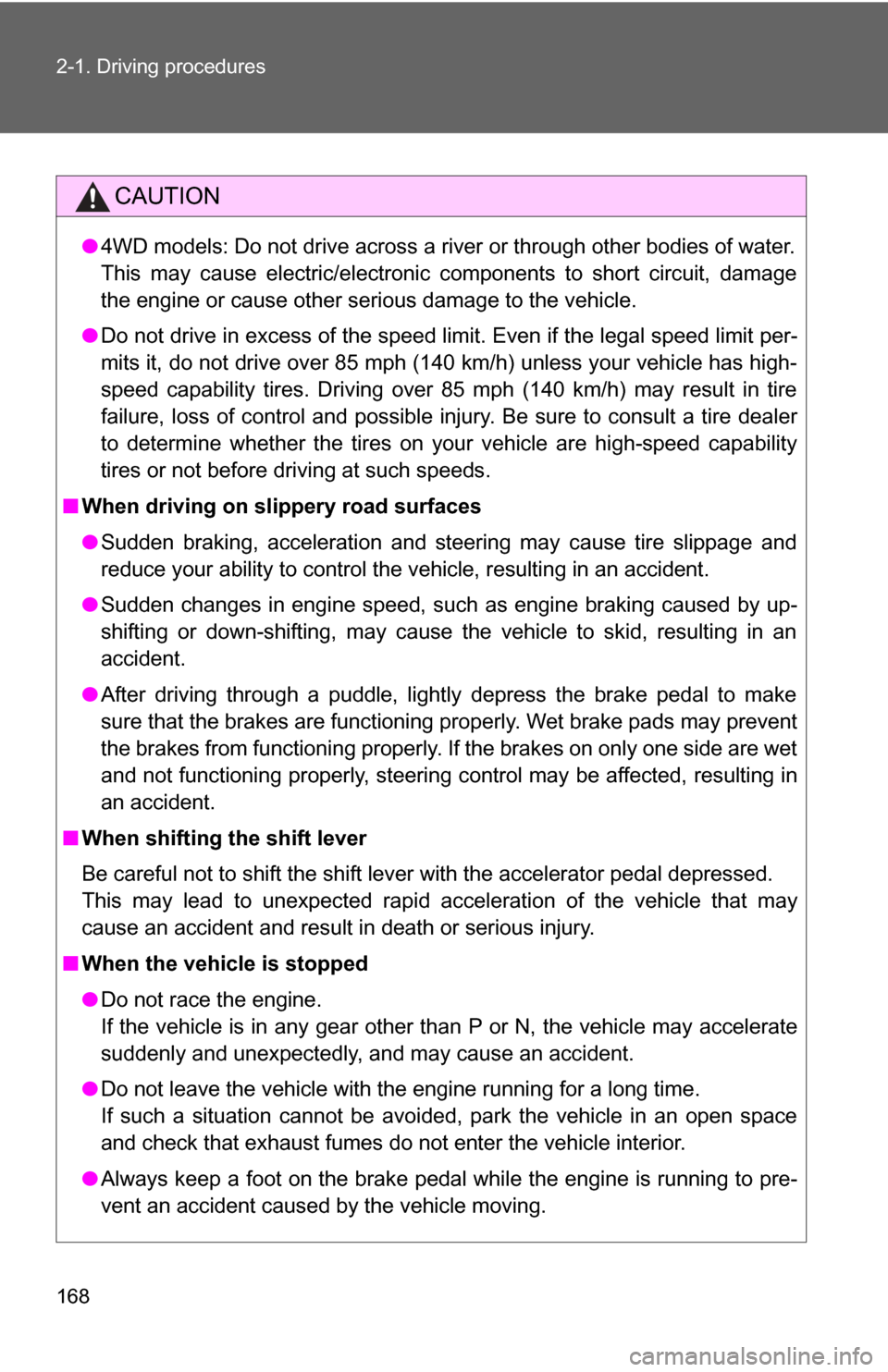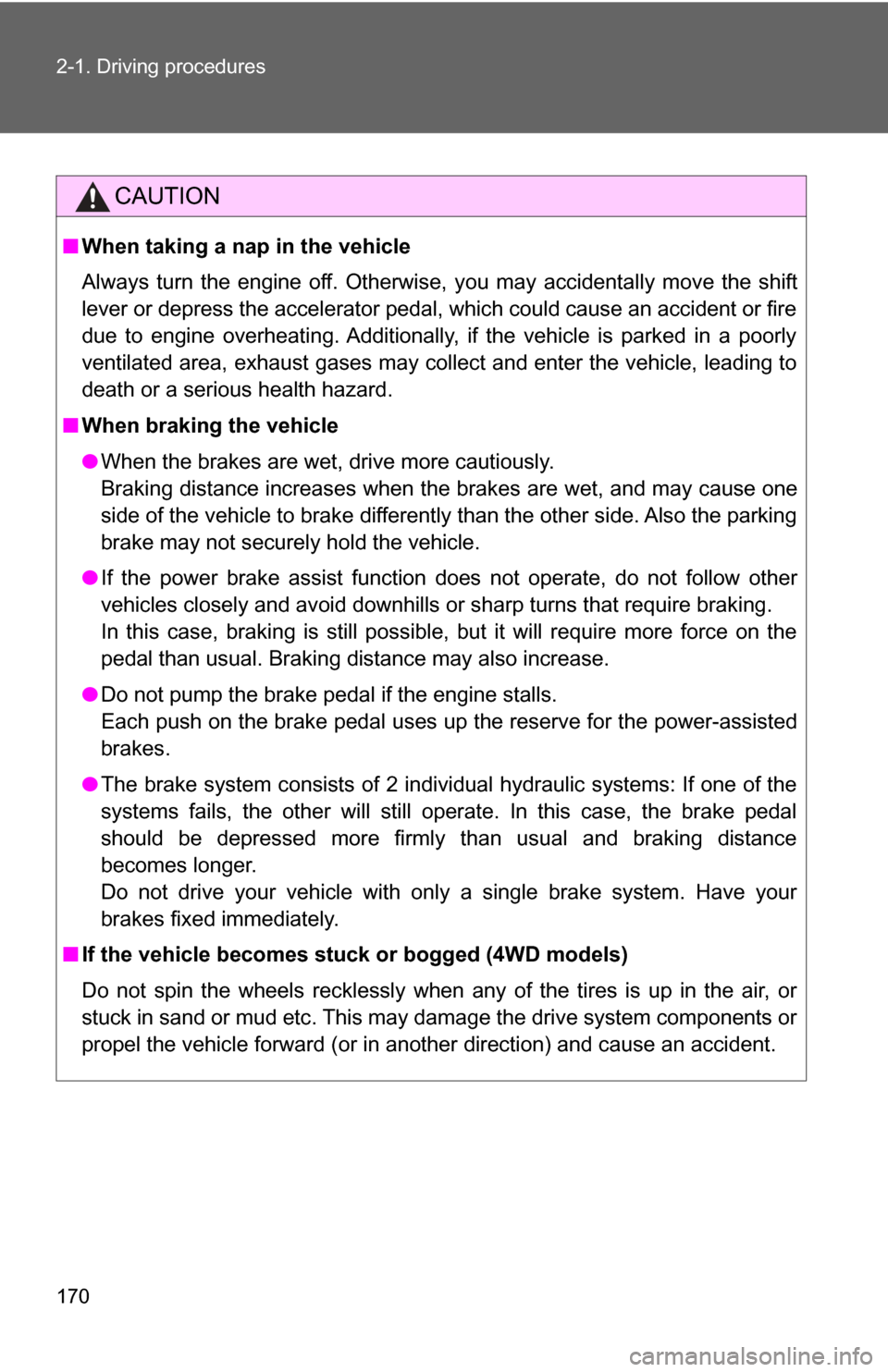2009 TOYOTA HIGHLANDER 4WD
[x] Cancel search: 4WDPage 3 of 608

1
2
3
4
5
6
7
3
2-3. Operating the lights and wipers
Headlight switch .................. 203
Fog light switch ................... 207
Windshield wipers and washer .............................. 208
Rear window wiper and washer .............................. 210
2-4. Using other driving systems Cruise control ...................... 211
Rear view monitor system (vehicles with
multi-information
display) ............................. 214
Driving assist systems ........ 218
Hill-start assist control ......... 223
Downhill assist control system
(4WD models only) ........... 225
2-5. Driving information Off-road precautions ........... 228
Cargo and luggage ............. 233
Vehicle load limits ............... 237
Winter driving tips ............... 238
Trailer towing ...................... 242
Dinghy towing ..................... 252 3-1. Using the air conditioning
system and defogger
Front manual air conditioning system.......... 256
Front automatic air conditioning system.......... 263
Rear manual air conditioning system.......... 271
Rear automatic air conditioning system.......... 274
Rear window and outside rear view mirror
defoggers ......................... 277
Windshield wiper de-icer .... 279
Using the steering wheel climate remote control
switches ........................... 280
3-2. Using the audio system Audio system ...................... 281
Using the radio ................... 284
Using the CD player ........... 290
Playing back MP3 and WMA discs ....................... 297
Optimal use of the audio system .................... 304
Using the AUX adapter....... 307
Using the steering wheel audio switches.................. 309
3Interior features
Page 11 of 608

11
A
Power outlet P. 392
Cup holders
Auxiliary box P. 379
P. 384
*: 4WD models
Cup holders P. 379
Shift lever P. 180
“SNOW” switch P. 181“DAC” switch* P. 225
Shift lock
override button
P. 537
Page 163 of 608

When driving2
163
2-1. Driving proceduresDriving the vehicle............ 164
Engine (ignition) switch (vehicles with smart
key system).................... 173
Engine (ignition) switch (vehicles without smart
key system).................... 177
Automatic Transmission ................. 180
Turn signal lever .............. 185
Parking brake ................... 186
Horn ................................. 187
2-2. Instrument cluster Gauges and meters ......... 188
Indicators and warning lights .............................. 190
Multi-information display............................ 194 2-3. Operating the lights and
wipers
Headlight switch ............... 203
Fog light switch ................ 207
Windshield wipers and washer ........................... 208
Rear window wiper and washer ........................... 210
2-4. Using other driving systems Cruise control ................... 211
Rear view monitor system (vehicles with multi-
information display) ........ 214
Driving assist systems ..... 218
Hill-start assist control ...... 223
Downhill assist control system
(4WD models
only)......... 225
2-5. Driving information Off-road precautions ........ 228
Cargo and luggage .......... 233
Vehicle load limits ............ 237
Winter driving tips ............ 238
Trailer towing ................... 242
Dinghy towing .................. 252
Page 167 of 608

167
2-1. Driving procedures
2
When driving
CAUTION
●
Do not let the vehicle roll backwards while the shift lever is in a driving
position, or roll forward while the shift lever is in R.
Doing so may cause the engine to stall or lead to poor brake and steering
performance, resulting in an accident or damage to the vehicle.
● If the smell of exhaust is noticed inside the vehicle, open the windows and
check that the back door is closed. Large amounts of exhaust in the vehi-
cle can cause driver drowsiness and an accident, resulting in death or a
serious health hazard. Have the vehicle inspected by your Toyota dealer
immediately.
● Do not under any circumstances shift the shift lever to P, R or N while the
vehicle is moving.
Doing so can cause significant damage to the transmission system and
may result in a loss of vehicle control.
● Do not shift the shift lever to N while the vehicle is moving.
Doing so may cause the engine brake to not operate properly and lead to
an accident.
● Do not turn the engine off while driving.
The power steering and brake booster systems will not operate properly if
the engine is not running.
● Use engine braking (downshift) to maintain a safe speed when driving
down a steep hill.
Using the brakes continuously may cause the brakes to overheat and lose
effectiveness. ( →P. 181)
● When stopped on an inclined surface, use the brake pedal and parking
brake to prevent the vehicle from rolling backward or forward and causing
an accident.
● Do not adjust the position of the steering wheel, the seat, or the inside or
outside rear view mirrors while driving.
Doing so may result in a loss of vehicle control that can cause accidents
that may result in death or serious injury.
● Always check that all passengers' arms, heads or other parts of their bod-
ies are not outside the vehicle, as this may result in death or serious injury.
● Do not drive the vehicle off-road.
This is not a 4WD vehicle designed for real off-road driving. Proceed with
all due caution if it becomes unavoidable to drive off-road.
Page 168 of 608

168 2-1. Driving procedures
CAUTION
●4WD models: Do not drive across a river or through other bodies of water.
This may cause electric/electronic components to short circuit, damage
the engine or cause other serious damage to the vehicle.
● Do not drive in excess of the speed limit. Even if the legal speed limit per-
mits it, do not drive over 85 mph (140 km/h) unless your vehicle has high-
speed capability tires. Driving over 85 mph (140 km/h) may result in tire
failure, loss of control and possible injury. Be sure to consult a tire dealer
to determine whether the tires on your vehicle are high-speed capability
tires or not before driving at such speeds.
■ When driving on slippery road surfaces
●Sudden braking, acceleration and steering may cause tire slippage and
reduce your ability to control the vehicle, resulting in an accident.
● Sudden changes in engine speed, such as engine braking caused by up-
shifting or down-shifting, may cause the vehicle to skid, resulting in an
accident.
● After driving through a puddle, lightly depress the brake pedal to make
sure that the brakes are functioning properly. Wet brake pads may prevent
the brakes from functioning properly. If the brakes on only one side are wet
and not functioning properly, steering control may be affected, resulting in
an accident.
■ When shifting the shift lever
Be careful not to shift the shift lever with the accelerator pedal depressed.
This may lead to unexpected rapid acceleration of the vehicle that may
cause an accident and result in death or serious injury.
■ When the vehicle is stopped
●Do not race the engine.
If the vehicle is in any gear other than P or N, the vehicle may accelerate
suddenly and unexpectedly, and may cause an accident.
● Do not leave the vehicle with the engine running for a long time.
If such a situation cannot be avoided, park the vehicle in an open space
and check that exhaust fumes do not enter the vehicle interior.
● Always keep a foot on the brake pedal while the engine is running to pre-
vent an accident caused by the vehicle moving.
Page 170 of 608

170 2-1. Driving procedures
CAUTION
■When taking a nap in the vehicle
Always turn the engine off. Otherwise, you may accidentally move the shift
lever or depress the accelerator pedal, which could cause an accident or fire
due to engine overheating. Additionally, if the vehicle is parked in a poorly
ventilated area, exhaust gases may collect and enter the vehicle, leading to
death or a serious health hazard.
■ When braking the vehicle
●When the brakes are wet, drive more cautiously.
Braking distance increases when the brakes are wet, and may cause one
side of the vehicle to brake differently than the other side. Also the parking
brake may not securely hold the vehicle.
● If the power brake assist function does not operate, do not follow other
vehicles closely and avoid downhills or sharp turns that require braking.
In this case, braking is still possible, but it will require more force on the
pedal than usual. Braking distance may also increase.
● Do not pump the brake pedal if the engine stalls.
Each push on the brake pedal uses up the reserve for the power-assisted
brakes.
● The brake system consists of 2 individual hydraulic systems: If one of the
systems fails, the other will still operate. In this case, the brake pedal
should be depressed more firmly than usual and braking distance
becomes longer.
Do not drive your vehicle with only a single brake system. Have your
brakes fixed immediately.
■ If the vehicle becomes stuck or bogged (4WD models)
Do not spin the wheels recklessly when any of the tires is up in the air, or
stuck in sand or mud etc. This may damage the drive system components or
propel the vehicle forward (or in another direction) and cause an accident.
Page 172 of 608

172 2-1. Driving procedures
NOTICE
■When encountering flooded roads
Do not drive on a road that has flooded after heavy rain etc. Doing so may
cause the following serious damage to the vehicle.
●Engine stalling
● Short in electrical components
● Engine damage caused by water immersion
In the event that you drive on a flooded road and the vehicle is flooded, be
sure to have your Toyota dealer check the following.
● Brake function
● Changes in quantity and quality of oil and fluid used for the engine, tran-
saxle, transfer (4WD models), differential (4WD models), etc.
● Lubricant condition for the propeller shaft (4WD models), bearings and
suspension joints (where possible) and the function of all joints, bearings,
etc.
Page 191 of 608

191
2-2. Instrument cluster
2
When driving
Center panel (vehicles
with navigation system)
■ Indicators
The indicators inform the driver of the operating state of the
vehicle’s various systems.
Turn signal indicator
( →P. 185)
(U.S.A.)
Headlight indicator
( →P. 203)
Headlight high beam
indicator ( →P. 205)
(Canada)
Tail light indicator
(→P. 203)
(4WD models)
Downhill assist control
system indicator
(→P. 225)
(if equipped)
Front fog light indicator
( →P. 207)
Slip indicator
(→P. 219)“SNOW” indicator
( →P. 181)
*
*